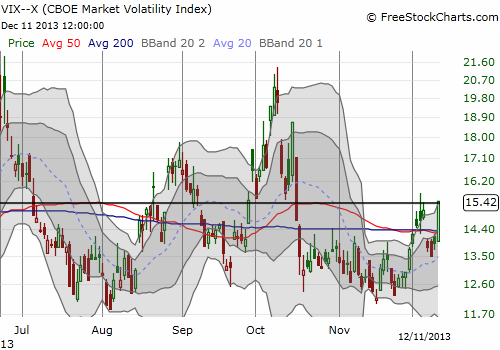(T2108 measures the percentage of stocks trading above their respective 40-day moving averages [DMAs]. It helps to identify extremes in market sentiment that are likely to reverse. To learn more about it, see my T2108 Resource Page. You can follow real-time T2108 commentary on twitter using the #T2108 hashtag. T2108-related trades and other trades are posted on twitter using the #120trade hashtag)
T2108 Status: 33.5%
VIX Status: 15.4
General (Short-term) Trading Call: Aggressive traders experiencing whiplash. Need to hold now and look for confirmation…OR continue taking small bets until market follows through in a given direction. More below.
Active T2108 periods: Day #116 over 20% (overperiod), Day #1 under 40% (underperiod), Day #7 under 50%, Day #24 under 60%, Day #29 under 70%
Reference Charts (click for view of last 6 months from Stockcharts.com):
S&P 500 or SPY
SDS (ProShares UltraShort S&P500)
U.S. Dollar Index (volatility index)
EEM (iShares MSCI Emerging Markets)
VIX (volatility index)
VXX (iPath S&P 500 VIX Short-Term Futures ETN)
EWG (iShares MSCI Germany Index Fund)
CAT (Caterpillar)
Commentary
The upside resolution that I described on Monday (2 days ago) quickly dissolved today. T2108 plunged a nasty 24% to close near its lows for the day at 33.5%. The S&P 500 (SPY) was in full agreement with the bearish sentiment as the index descended below 1800 again. It closed with a loss of 1.1% (which qualifies as large these days) and closed at the lows of the day. The small irony of today’s tumble is that the warning signs showed up to me early, but I ignored them since I was convinced of the upside resolution. Given my bullish assessment, I fully expected good follow-through on T2108. Instead, on Tuesday, T2108 dipped about 7% even as the S&P 500 closed essentially flat. That non-confirmation should have forced me to quickly re-examine my assessment. Fortunately, there is still plenty of time to correct course.
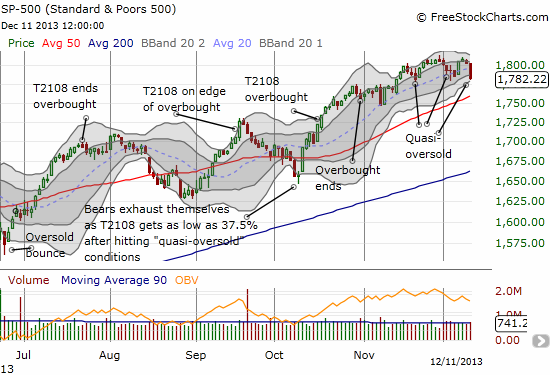
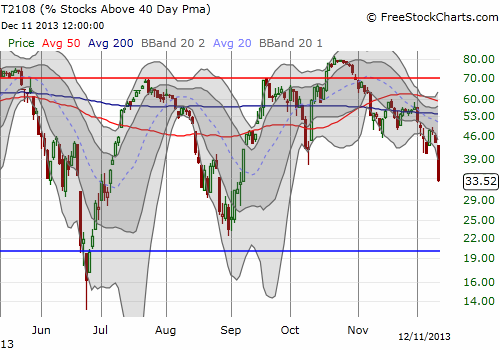
Note how the volatility index, the VIX, magically surged right into the pivot point that has lasted since 2010 (and arguably served as an important pivot/support in 2007 and 2008). Based on this move, I decided to fade one of the volatility indices. I decided to buy puts on ProShares Ultra VIX Short-Term Futures ETF (UVXY) although I still have a small number of shares long iPath S&P 500 VIX ST Futures ETN (VXX). My rationale is that volatility will cave between now and the immediate wake of next week’s Federal Reserve meeting, leading to the next sharp downslide in products like UVXY.
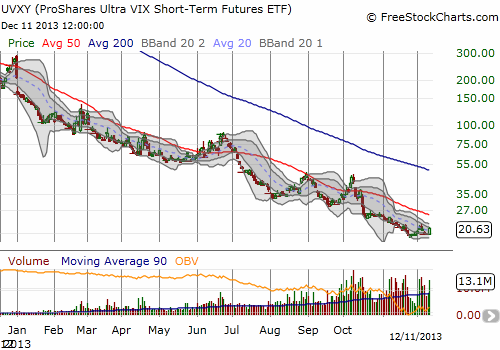
First things first though. My first tranche of UVXY puts could be too early. The plunge in T2108 created yet another episode of quasi-oversold conditions. HOWEVER, in this case, T2108 has hit an interesting air pocket where the T2108 Trading Model (TTM) is anticipating more downside for tomorrow (Thursday, December 12th). The combination of conditions creating a 22% chance of downside is an increase in the VIX of at least 5.3% and a T2108 close between 30.5% and 36.1%. This combination has happened just 9 times since 1986 (my entire set of historical data) and 7 of those times preceded downside. If T2108 had closed below 30.5%, then he odds would have sharply shifted in favor of upside for the next day.
The 1 and 2-day change in T2108 did not factor into the projection. Neither did the S&P 500’s position relative to its major moving averages. The overall classification error for the T2108 Trading Model has increased a bit to 42%, so I only focus on high frequency nodes like the current one for trading purposes. (In coming months, I am going to do additional tinkering to reduce the overall classification error. In particular, the TTM is simply not good to apply under certain trading conditions).
The upshot of these high odds for another day of selling is that the odds of true oversold conditions (T2108 at 20% or below) suddenly seem pretty good: it could take just two more days like the last two.
Without true oversold conditions, my bias returns to overall bearish on the S&P 500 until it can close once again over 1800 OR hit true oversold conditions. The current churn around 1800 is unfortunate, but my assumption is that this action is a springboard for the next sustained move. I thought December would pass quietly, but signs are once again indicating otherwise. Aggressive traders can re-open short positions but prepare for churn: stops must stay in place at new all-time highs. Another option is to just stand down until the market sends confirmation with a new all-time high OR follow-through from current selling…keeping in mind that the coming Fed meeting may provide the final pivot point.
I conclude with charts of the euro. One of the most bizarre events (for me anyway) is watching the stubborn strength of the euro (FXE). I hope to dedicate a post to this soon. My main contention is that the eurozone is the weakest economic zone amongst the major economies so it makes little sense for the euro to continue the current domination over so many major currencies…especially if tapering fears (or actual tapering) sends bond rates higher in the U.S. and/or a strengthening economy matches up with the Fed’s pullback from stimulus. Given current momentum, and the ECB’s refusal to attack the high euro head on, it is looking like early 2014 before the euro once again experiences a significant pullback. This could be the biggest forex profit opportunity to start the new year. I am going to stay small and patient on my euro shorts until then.

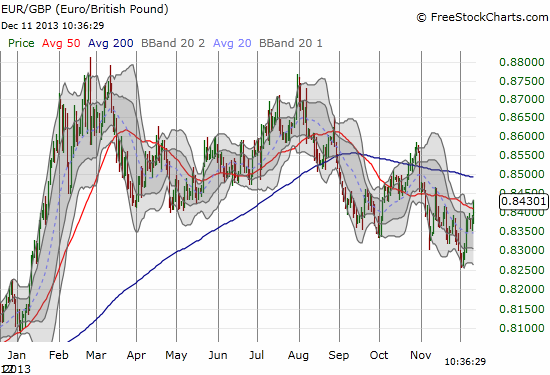
Daily T2108 vs the S&P 500

Black line: T2108 (measured on the right); Green line: S&P 500 (for comparative purposes)
Red line: T2108 Overbought (70%); Blue line: T2108 Oversold (20%)
Weekly T2108

*All charts created using freestockcharts.com unless otherwise stated
Related links:
The T2108 Resource Page
Expanded daily chart of T2108 versus the S&P 500
Expanded weekly chart of T2108
Be careful out there!
Full disclosure: long SSO puts and calls, long UVXY puts, long VXX shares, net short euro

